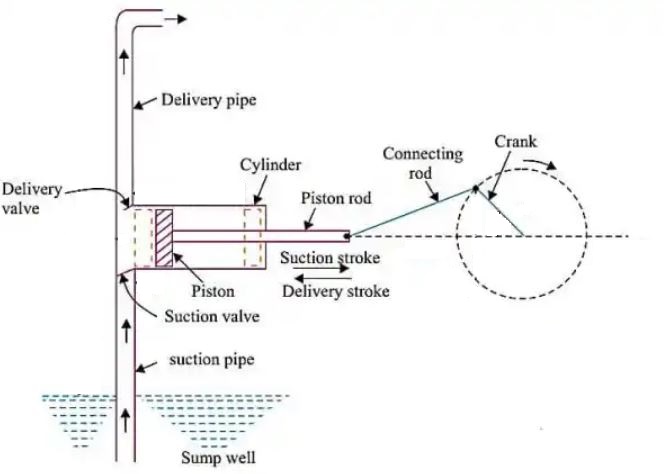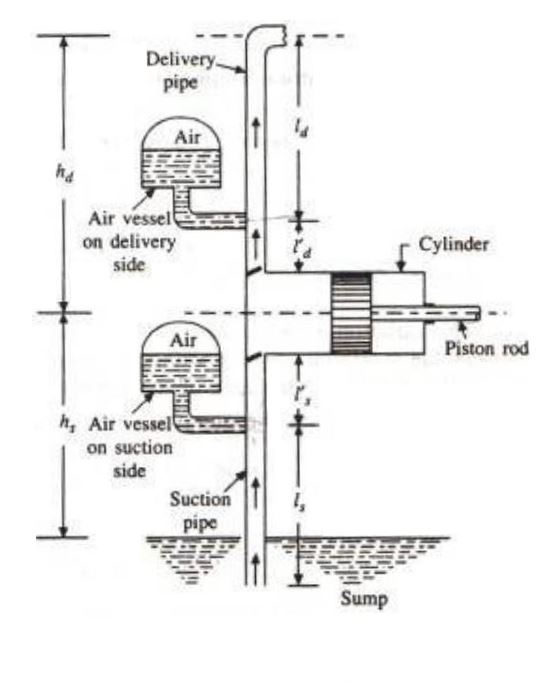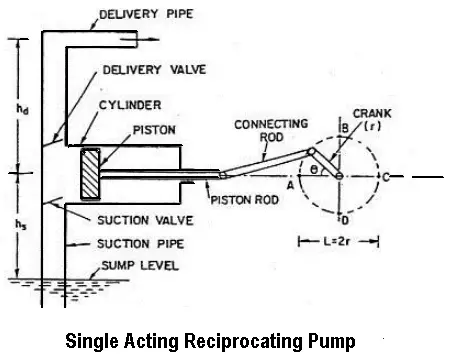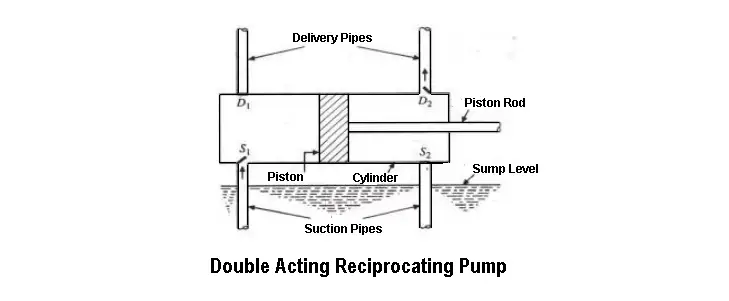In this article, we are discussing what is a Reciprocating pump, its parts, types, working principle, uses, and the difference between a reciprocating pump and a centrifugal pump.
Reciprocating Pump
A reciprocating pump is also known as a positive displacement pump. It is a device that converts mechanical energy into hydraulic energy by sucking the liquid into a cylinder, it discharges a definite quantity of liquid. It is often used where a small quantity of liquid is to be handled and where delivery pressure is quite significant.
That means it is commonly used when you need to move a precise amount of liquid, and you need to do it with a lot of force.
They are capable of producing high-pressure output, which makes them suitable for various industries and applications such as hydraulic systems, waterjet cutting machines, oil and gas processing, high-pressure washing, and more. Their ability to deliver a precise amount of liquid under high pressure makes them valuable in situations where accuracy and control are important.
Read also: What is Centrifugal Pump? and Its Working Principle
Parts of Reciprocating Pump
The following are the main parts of the reciprocating pump.
- Cylinder
- Suction Pipe
- Delivery Pipe
- Suction valve
- Delivery valve
- Piston and piston rod
- Crank and connecting rod
- Strainer
- Air vessels

#1 Cylinder
The cylinder is the main chamber of the pump where the reciprocating motion of the piston occurs. The moment of the piston is obtained by a connecting rod, which connects the piston and crank.
It contains the liquid being pumped and provides a sealed environment for the piston to move back and forth. The cylinder is typically made of durable materials such as cast iron or stainless steel to withstand the pressure and wear associated with pumping.
#2 Suction Pipe
The suction pipe is a tube that connects the pump to the liquid source, such as a reservoir or tank. It allows the pump to draw liquid into the cylinder during the suction stroke. The diameter and length of the suction pipe are important factors affecting the pump’s efficiency and ability to prime (fill with liquid).
#3 Delivery Pipe
The delivery pipe carries the pressurized liquid from the pump cylinder to its destination or point of use. It connects the cylinder of the pump to the outlet source. It is designed to withstand the pressure generated by the pump and deliver the liquid efficiently to the desired location.
#4 Suction Valve
The suction valve is installed in the suction pipe. In this valve, the flow of water enters from the suction pipe into the cylinder. During the suction stroke, the valve opens to allow the liquid to flow into the cylinder, and during the discharge stroke, it closes to prevent backflow. Hence it is also known as a non-return valve. This valve ensures that the liquid moves only in the desired direction, from the source into the pump cylinder.
#5 Delivery Valve
Similar to the suction valve, the delivery valve is a one-way valve installed in the delivery pipe. It opens during the discharge stroke to allow the pressurized liquid to flow out of the cylinder and closes during the suction stroke to prevent backflow. This valve ensures that the liquid moves only in the desired direction, from the pump cylinder to the delivery point.
#6 Piston and Piston Rod
The piston is a cylindrical component that fits inside the cylinder and moves back and forth in response to the rotational motion of the crankshaft. Whereas the piston rod helps the piston to move in a linear direction.
#7 Crank and Connecting Rod
A crank is a circular disc that is connected to a motor. While the connecting rod connects the crank to the piston. As a result, the rotational motion of the crank is converted into linear movement of the piston. This rotational motion drives the pump’s operation.
#8 Strainer
The strainer is a filter or mesh located at the end of the suction pipe or inside the pump cylinder. Its purpose is to prevent debris, solid particles, or foreign objects from entering the pump and causing damage to its components. By filtering out contaminants, the strainer helps maintain the efficiency and reliability of the pump.
#9 Air Vessels
It is a closed chamber made up of cast iron. It has two ends. One end is open at its base through which the water flows into the vessel cylinder. The air vessels are fitted to the suction pipe and delivery pipe of this pump to get a uniform discharge.
It contains compressed air that acts as a cushion to absorb pressure fluctuations and water hammer effects. During operation, the air vessel helps stabilize the flow of liquid and reduces the risk of damage to the pump and pipeline system.

Types of Reciprocating Pump
Mainly reciprocating pumps are categorized into two types:
- A double-acting reciprocating pump
- Single-acting reciprocating pump
Other types include:
Simple hand-operated reciprocating pumpPower-operated deep well reciprocating pump- Triple-acting reciprocating pump
- Pump with air vessels
- Pump without air vessels
1. Single Acting Reciprocating Pump
In this pump, A cylinder, in which a piston moves forward and backward. The piston is reciprocated using the connecting rod. The connecting rod connects the piston and the rotating crank. The crank is rotating using an electric motor.
The suction and delivery pipes with suction and delivery valves are arranged to the cylinder.

- The suction valve allows the water into the cylinder and
- The delivery valve leaves the water from the cylinder.
As the crank rotates, during the first stroke of the piston (called suction stroke), the water enters the cylinder. In a suction stroke, the crank is rotating from A to C (from 0° to 180°) the piston is moving towards the right side of the cylinder. Due to this, a vacuum is created in the cylinder. This vacuum causes the suction valve to open and the water enters the cylinder.
In the next stroke called the delivery stroke, the water leaves the cylinder. In the delivery stroke, the crank is rotating from C to A (from 180° to 360°) the piston is moving to the left side of the cylinder. Due to this, the pressure of the liquid increases inside the cylinder. This pressure causes the suction valve to close and the delivery valve to open. Then the water is forced into the delivery pipe and raised to the required height.
2. Double Acting Reciprocating Pump
In this, the water is acting on both sides of the piston as shown in the figure.

Thus two suction pipes and two delivery pipes are required for a double-acting pump. When there is a suction stroke on one side of the piston, at the same time there is a delivery stroke on the other side of the piston.
Hence for one complete revolution of the crank, there are two delivery strokes, and the water is delivered to the pipes by the pump during these two delivery strokes.
Read also: Difference Between Hydraulic and Pneumatic
How Reciprocating Pump Works?
When the crank connects to the power source (motor), it will start rotating, and the connecting rod and the crank will also be in movement. As the piston is attached to the connecting rod, it will also start moving in a linear direction.
When the crank is moved outwards, the piston moves to its right, creating a vacuum in the cylinder. This causes the suction valve to open. Now, the liquid from the source is sucked into the cylinder by the suction pipe.
Similarly, when the crank moves inwards of the cylinder, the piston will move to its left, compressing the liquid in the cylinder. At this point, pressure is generated, causing the delivery valve to open, and the liquid flows through the delivery pipe.
Finally, the piston reaches its extreme left position, and all the liquid in the cylinder is delivered through the delivery valve. Again, the crank spins outwards, and the piston moves to the right to create suction, and the process is repeated.
Difference Between Centrifugal Pump and Reciprocating Pump
| Centrifugal Pump | Reciprocating Pump |
|---|---|
| This pump is simple in construction due to less number of parts. | It is suitable for large discharges with small heads. |
| Centrifugal pump has more weight for a given discharge. | The reciprocating pump has less weight for a given discharge. |
| Its delivery is pulsating and does not needs priming. | It is suitable for large discharges with small heads. |
| It requires more floor space and it has a heavy foundation. | It requires less space and it has a simple foundation. |
| This pump has less wear and tear and it can handle dirty water. | This pump has more wear and tear and it cannot handle dirty water. |
| Its delivery is continuous and needs priming. | The reciprocating pump has high efficiency and it cannot run at higher speeds. |
| Centrifugal pump has low efficiency and it can run at higher speeds. | It cannot require air vessels and operation is quiet. |
| In this pump, the thrust on the crank is uniform. | It cannot require air vessels and operation is quiet. |
| The maintenance cost of the pump is less. | The maintenance cost of the pump is high. |
| Its delivery is pulsating and does not need priming. | In this pump, the thrust on the crank is uniform. |
Application of Reciprocating Pumps
- The reciprocating pump is used in oil drilling operations.
- It is helpful in pneumatic pressure systems.
- Primarily used in light oil pumping.
- It is used for feeding small boilers condensate return.
Advantages and Disadvantages of Reciprocating Pump
Following are the advantages and disadvantages of reciprocating pump:
- These pumps can maintain a constant discharge rate while precisely delivering the desired flow rate.
- In addition, reciprocating pumps can deliver fluids at high pressures without the need for priming.
- These pumps have a very high capital expense. Also, these pumps have a low flow rate.
- A reciprocating pump has a higher efficiency than a centrifugal pump by at least 10% to 20%.
- Since there are so many parts involved in reciprocating pumps, they cannot pump viscous liquids, and their maintenance costs are very high.
Conclusion
That’s it, thanks for reading. So now, we hope that we have cleared all your doubts about Reciprocating Pump. If you still have doubts about this article, you can contact us or ask in the comments. If you like our article, then please share it with your friends.
Subscribe to our newsletter to get notified when we upload new posts.
Download PDF of this article:
You may be interested in reading these articles:
- What is the Heat Treatment Process?
- What is the Extrusion Process? Its Types & Uses
- Understand The Types of Threads [Complete Guide]
- Types of Fasteners & Their Uses
External Links:
Frequently Asked Questions
The act of reciprocating itself is referred to as reciprocating action. It means to take an action in response to one particular action that is similar to or identical to the earlier action.
When a precise amount of fluid needs to be delivered, reciprocating pumps are used. Likewise, the pumps are used when the required delivery pressure is greater than what can be obtained using other types.
Both have advantages, with centrifugal being the less expensive option and reciprocating being the more complicated option. However, which one is better depends on the type of area in which they will be working.
Reciprocating pump designs can handle a wide range of liquid properties, including low-viscosity chemicals, slurries with high particle content, and high-viscosity liquids. Due to their wide operating range, they tend to be the technology of choice for challenging applications.
Many installations of reciprocating pumps experience issues that can result in high maintenance costs and unstable performance. Examples of this include noise and vibration in the pump and piping. Vibration can cause parts like valves, crossheads, crankshafts, piping, and even pump barrels to fail and perform poorly.
Hey ! Nice Article you I loved your information for Differance between CF and RC Pump i got some new terms and you shorts in briefly,
thank you for sharing and spreading knowledge !!!
Thank you 🙂